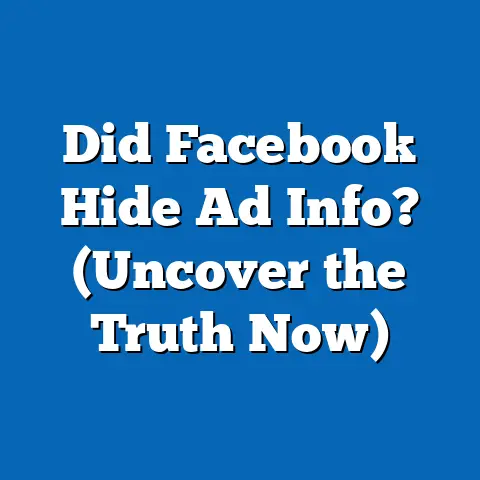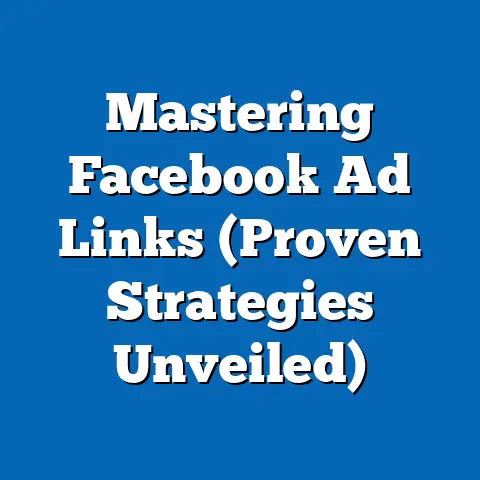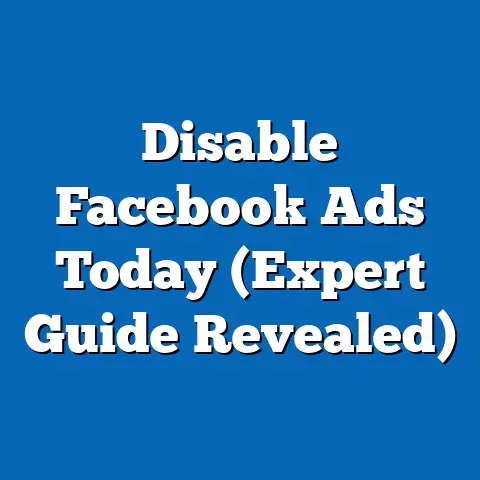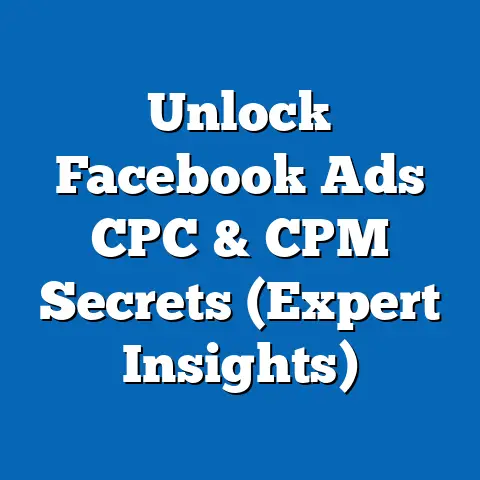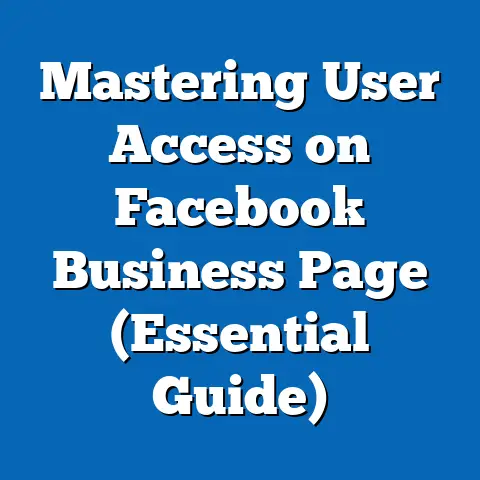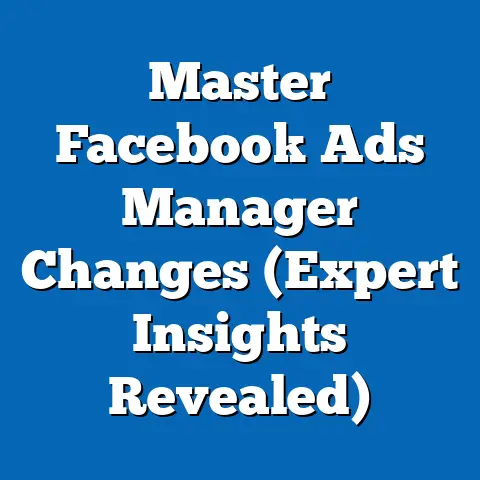Maximize Engagement with Facebook Feed Ads (Proven Strategies)
Facebook remains a powerhouse for businesses seeking to connect with their target audience. I’ve seen firsthand how a well-executed Facebook advertising strategy can transform a business, driving not just brand awareness but also tangible conversions. Within the platform, Facebook Feed Ads stand out as a particularly effective tool for capturing attention and sparking interaction.
However, the key to unlocking the full potential of Facebook Feed Ads lies in understanding the nuances of budget allocation. It’s not just about throwing money at the platform; it’s about strategically investing in the right audiences, the right content, and the right formats. A poorly planned budget can lead to wasted ad spend and disappointing results, while a well-optimized budget can amplify your reach, boost engagement, and ultimately drive a higher return on investment.
In this guide, I’ll walk you through proven strategies for maximizing engagement with Facebook Feed Ads. We’ll explore everything from understanding your audience and crafting compelling content to leveraging different ad formats, A/B testing, and retargeting techniques. By the end of this article, you’ll have a clear roadmap for creating Facebook ad campaigns that not only reach your target audience but also inspire them to take action.
1. Understanding Your Audience
Audience targeting is the bedrock of any successful Facebook Feed Ad campaign. It’s not enough to simply create a great ad; you need to ensure that it’s being seen by the right people. I remember once launching a campaign for a local bakery without properly defining the target audience. The results were underwhelming, to say the least. It wasn’t until I delved into Facebook’s audience insights and refined my targeting that I started to see a significant improvement in engagement.
Here’s how to effectively understand your audience:
- Utilize Facebook Audience Insights: This powerful tool provides a wealth of data about your target audience, including their demographics, interests, behaviors, and even their purchasing habits. I often start here to get a broad overview of potential customers.
- Analyze Your Existing Customer Data: Your current customer base is a goldmine of information. Look at their demographics, purchase history, and engagement with your brand on social media. This data can help you identify patterns and create more accurate buyer personas.
- Create Buyer Personas: Develop detailed profiles of your ideal customers, including their age, gender, location, occupation, interests, pain points, and motivations. I find that giving these personas names and even finding stock photos of people who resemble them helps to bring them to life and make them more relatable.
- Segment Your Audiences: Don’t treat all potential customers the same. Segment your audience based on demographics, interests, behaviors, or even their stage in the customer journey. This allows you to tailor your ad content to specific groups, increasing its relevance and impact.
For example, if you’re selling fitness apparel, you might segment your audience into “yoga enthusiasts,” “runners,” and “weightlifters,” each with their own unique ad copy and visuals. I’ve seen this level of personalization dramatically increase click-through rates and engagement.
Takeaway: Invest time in understanding your audience. Use Facebook Audience Insights, analyze your existing customer data, create buyer personas, and segment your audiences to tailor your ad content effectively.
2. Crafting Compelling Ad Content
Even with perfect targeting, your Facebook Feed Ads will fall flat if the content isn’t engaging. I’ve learned that people are bombarded with ads every day, so you need to stand out from the crowd and capture their attention within seconds.
Here are some key elements of compelling ad content:
- Eye-Catching Visuals: High-quality images and videos are essential for grabbing attention. Use visuals that are relevant to your target audience and that evoke emotion. I’ve found that user-generated content often performs exceptionally well because it feels more authentic and relatable.
- Compelling Copy: Your ad copy should be concise, clear, and persuasive. Highlight the benefits of your product or service and explain why it’s relevant to the viewer. Use strong verbs and action-oriented language to encourage clicks.
- Attention-Grabbing Headlines: Your headline is the first thing people will see, so make it count. Use numbers, questions, or intriguing statements to pique their curiosity. I often test multiple headlines to see which ones perform best.
- Storytelling: People connect with stories. Use your ads to tell a story that resonates with your target audience and that highlights the value of your brand. I’ve seen brands create incredibly effective ads simply by sharing customer testimonials.
- Clear Call-to-Action (CTA): Tell people exactly what you want them to do. Use clear and concise CTAs like “Shop Now,” “Learn More,” “Sign Up,” or “Get Started.” I’ve found that using a CTA button that contrasts with the background of the ad can significantly increase click-through rates.
Remember, your ad content should be tailored to your target audience. What resonates with one group might not resonate with another. That’s why it’s essential to test different ad creatives and copy to see what performs best.
Takeaway: Create compelling ad content that captures attention, evokes emotion, and encourages action. Use high-quality visuals, persuasive copy, attention-grabbing headlines, storytelling, and clear CTAs.
3. Utilizing Facebook Ad Formats
Facebook offers a variety of ad formats, each with its own strengths and weaknesses. I’ve found that choosing the right format can significantly impact the engagement and performance of your ads.
Here’s a breakdown of some of the most popular Facebook Ad formats:
- Single Image Ads: These are the simplest and most common ad format. They consist of a single image, headline, copy, and CTA. I’ve found that they work well for showcasing a product or service in a visually appealing way.
- Carousel Ads: Carousel ads allow you to showcase multiple images or videos in a single ad. Each image or video has its own headline, copy, and CTA. I’ve seen these ads perform exceptionally well for showcasing a range of products or services, or for telling a story in multiple steps.
- Video Ads: Video ads are a powerful way to capture attention and convey a message. They can be used to showcase a product demo, share a customer testimonial, or simply tell a story. I’ve found that shorter videos (under 15 seconds) tend to perform best on Facebook.
- Slideshow Ads: Slideshow ads are a cost-effective way to create video-like experiences using a series of still images. They’re easy to create and can be used to showcase a product or service in a dynamic way. I often use slideshow ads for retargeting campaigns.
- Collection Ads: Collection ads are designed to showcase products in a visually appealing way. They typically feature a main image or video, followed by a grid of related products. I’ve found that these ads work well for e-commerce businesses looking to drive sales.
The best ad format for your business will depend on your specific goals and target audience. I recommend experimenting with different formats to see what performs best for you.
Takeaway: Explore the various ad formats available on Facebook and choose the ones that best suit your goals and target audience. Experiment with different formats to see what performs best for you.
4. A/B Testing Strategies
A/B testing, also known as split testing, is the process of comparing two versions of an ad to see which one performs better. I consider it an essential part of any successful Facebook advertising strategy. I’ve learned that even small changes to your ad creative or targeting can have a significant impact on its performance.
Here’s how to effectively A/B test your Facebook Feed Ads:
- Identify Key Elements to Test: Focus on testing elements that are likely to have a significant impact on performance, such as headlines, images, CTAs, and audience segments. I typically start by testing one element at a time to isolate the impact of each change.
- Create Two Versions of Your Ad: Create two versions of your ad that are identical except for the element you’re testing. For example, if you’re testing headlines, create one ad with headline A and another ad with headline B.
- Set Up Your A/B Test: Use Facebook’s built-in A/B testing tool to set up your test. Define your test duration, budget, and target audience.
- Analyze the Results: Once your test is complete, analyze the results to see which version of your ad performed better. Look at metrics like click-through rate, conversion rate, and cost per acquisition.
- Implement the Winning Version: Implement the winning version of your ad and continue to test other elements to further optimize your campaign.
I’ve found that A/B testing is an ongoing process. Even after you’ve found a winning ad, it’s important to continue testing to ensure that it remains effective.
Takeaway: Use A/B testing to identify what resonates best with your target audience. Test different ad elements, analyze the results, and implement the winning versions to refine your ad strategies for higher engagement.
5. Leveraging Retargeting
Retargeting is a powerful advertising technique that allows you to show ads to people who have previously interacted with your brand. I’ve seen firsthand how retargeting can significantly increase conversion rates and drive repeat business.
Here’s how to effectively leverage retargeting in your Facebook Feed Ads:
- Install the Facebook Pixel: The Facebook Pixel is a small piece of code that you install on your website. It tracks the actions that people take on your website, such as viewing pages, adding items to their cart, or making a purchase.
- Create Custom Audiences: Use the Facebook Pixel to create custom audiences based on specific website actions. For example, you can create an audience of people who have visited your product pages but haven’t made a purchase.
- Craft Retargeting Ads: Create retargeting ads that are specifically designed to re-engage users who have previously interacted with your brand. Offer them a discount, remind them of the products they left in their cart, or simply show them a compelling reason to return to your website.
- Exclude Existing Customers: To avoid wasting ad spend, exclude existing customers from your retargeting campaigns. You can do this by creating a custom audience of your existing customers and excluding them from your targeting.
I’ve found that retargeting is particularly effective for e-commerce businesses. By showing ads to people who have previously viewed their products, they can significantly increase their chances of making a sale.
Takeaway: Use retargeting to re-engage users who have previously interacted with your brand but didn’t convert. Install the Facebook Pixel, create custom audiences, craft retargeting ads, and exclude existing customers.
Conclusion
Maximizing engagement with Facebook Feed Ads requires a strategic approach that encompasses budget planning, audience understanding, compelling content, format selection, A/B testing, and retargeting. By implementing these proven strategies, you can create Facebook ad campaigns that not only reach your target audience but also inspire them to take action.
Remember, Facebook advertising is an ongoing process. It’s important to continuously monitor your results, test new ideas, and adapt your strategies as needed. With a little effort and experimentation, you can unlock the full potential of Facebook Feed Ads and achieve your business goals. So, take these strategies, put them into action, and watch your Facebook advertising efforts transform your business!

